Trying to decide between the new 6.8 Western vs 7mm PRC cartridges? Here’s what you need to know about them.
I’ve never seen a cartridge that received as strong of an initial negative reaction when first released as was the case with Winchester and Browning’s 6.8 Western cartridge in 2021. To be fair, that new cartridge hit the market in the midst of a historically bad ammunition shortage and some of the darkest days of the COVID-19 pandemic.
Despite the negative reaction some people initially had regarding the 6.8 Western, thousands of hunters scooped up rifles in the new cartridge over the ensuring months and reviews from those who used it on deer, elk, bear, and other big game afield were nearly uniformly positive.
Fast forward to late 2022 and the situation was nearly reversed with another brand new offering from a different company: the 7mm Precision Rifle Cartridge from Hornady.
I’m not exaggerating when I say that I’ve never seen a cartridge make as big of a splash as the 7mm PRC did when it was introduced.
It’s only natural that many hunters would compare two of the newest rifle cartridges that have also evoked the strongest emotions for hunters and shooters to each other.
So, what’s the deal? Are the 6.8 Western and the 7mm PRC the latest flavor of the week? Or are they worthy choices for hunters and shooters to consider? If so, which one is better?
Both offer certain advantages to hunters, but there are some significant differences between the 6.8 Western vs 7mm PRC cartridges you should be aware of before purchasing a new rifle.
In this article, I investigate the 6.8 Western vs 7mm PRC debate in detail and provide some insight into which new rifle cartridge is ideally suited for various hunting situations so you can make an informed decision on which one will work best for your individual needs.
Additionally, I recorded an entire podcast episode on this exact subject. If you’d rather listen than read, click the appropriate link below to listen to this episode on your preferred podcasting service.
7mm PRC vs 6.8 Western Podcast
Apple | Google | iHeart | Pandora | Spotify
History Of The 6.8 Western & 7mm PRC
The story of these two cartridges starts back to 1925 with the introduction of the .270 Winchester.
Designed by necking down a .30-06 case to use .277″ instead of .308″ bullets, the original .270 Winchester load shot a 130 grain bullet at approximately 3,140 feet per second (2,846 ft-lbs of energy). Originally released with the fantastic Winchester Model 54 rifle, the cartridge developed a well-deserved reputation for effectiveness on thin-skinned game over the years.
Though not an immediate hit, the 270 Winchester cartridge eventually developed a large and devoted following during the course of the 20th Century and the .270 caliber became irrevocably linked to the Winchester brand.
As good as the 270 Winchester is though, shooters in the 21st Century lamented the relatively few choices for high BC hunting bullets available in .277″ caliber.
This is because the 270 Winchester (and the more recently developed 270 Winchester Short Magnum) has a SAAMI spec rifling twist rate of 1:10″. This twist rate worked quite well for the bullets in the 130gr-150gr weight range the cartridge was originally developed for.
Those bullets are incredibly effective for many hunting applications, but they don’t offer the sort of the extended performance more and more hunters and shooters are looking for these days. Shooters and hunters have started to place a much higher emphasis on long, heavy, and aerodynamic projectiles in recent years with the rise in popularity of long range shooting.
In response, the various ammunition manufacturers have worked to satisfy that demand with offerings using sleek, low drag bullets. The Nosler AccuBond Long Range, the Barnes LRX, the Hornady ELD-X, and the various Berger bullets are all great examples of extremely aerodynamic hunting projectiles that have really taken off in recent years.
Unfortunately, those slower rifling twist rates used by the .270 Winchester hampered development of long, heavy, low-drag bullets in .277″ caliber.
For example, there are several different hunting bullet options available in 6.5mm, 7mm, and .30 caliber with a G1 ballistic coefficient over .600 like the 143gr ELD-X in 6.5mm (.625 BC), the 168gr VLD Hunting in 7mm (.618 BC), and the 210gr AccuBond Long Range in .30 caliber (.661 BC). Comparable bullets in .277″ caliber include the 145gr ELD-X (.536 BC), 150gr VLD Hunting (.518 BC), and the 150gr AccuBond Long Range (.591 BC).
Yes, it’s true that hunters using custom rifles with fast enough rifling twist rates can use some of the very heavy and extremely aerodynamic 277″ caliber bullets available these days like the 170gr Berger Extreme Outer Limits (EOL) with a .662 G1 BC. Those heavy bullets simply aren’t an option for hunters who don’t handload and who use factory production rifles though.
That situation changed in early 2020 when Nosler rolled out their new 27 Nosler cartridge.
Designed from the start to use the new .277″ caliber 165gr AccuBond Long Range (.620 BC), 27 Nosler rifles used a faster 1:8.5″ rifling twist rate and took the performance of the .277″ caliber to the next level by allowing for the use of extremely high BC bullets in a .277″ caliber cartridge.
The Nosler cartridges in general are excellent performers that fire bullets with higher ballistic coefficients at very fast velocities. However, they’re still niche offerings and are primarily available in custom rifle builds (with a handful of exceptions).
Even so, the development of the 27 Nosler and the 165gr AccuBond Long Range set things in motion for subsequent developments in the future.
That next domino fell on 15 January 2021 when Browning and Winchester announced the release of the new 6.8 Western cartridge. Also known as the 6.8 Winchester Western, the announcement of the new round took some by surprise.
Instead of just revamping an older cartridge to use heavier bullets, designers at Winchester and Browning decided from the very beginning to build a purpose built cartridge that will handily outperform the old .270 Winchester and 270 WSM.
Basically, they wanted a new .277″ cartridge that offered magnum performance with very high BC bullets that would also fit in a short action rifle.
Here’s what Kyle Masinelli, Winchester’s lead engineer for the 6.8 Western, had to say about the new cartridge:
We wanted to get into the untapped potential of bullets above the .264 caliber. We only wanted bullets with G1 BCs above .600 and our goal was to beat the .300 Winchester Magnum’s 180-grain AccuBond’s energy delivery at 500 yards.
To that end, they borrowed a page out of the playbook used in other successful cartridge releases like the 6.5 PRC. Sharing some of the same physical characteristics of the 270 WSM and 6.5 PRC, the 6.8 Western has an overall length of 2.955″ and uses a beltless case that’s 2.02″ long, .535″ in diameter at the base, and has a 35 degree shoulder.
Though the 270 WSM cartridge has an overall length of 2.86″ and fits neatly into the traditional definition of a short action cartridge, the 6.8 Western exceeds those standards by a hair with a maximum cartridge overall length (COAL) of 2.955″. Even so, the 6.8 Western will feed reliably from short action AICS-pattern box magazines that are so common with modern rifles.
In addition to lengthening the COAL of the 6.8 Western, designers at Winchester moved the cartridge shoulder back slightly and decreased the case length compared to the 270 WSM. This resulted in a little bit more space for the bullet outside the case (also known as head height).
Head height is the amount of space available for the bullet outside the case while staying within SAAMI specifications for the cartridge. Put simply, more head height facilitates the use of very long, aerodynamic bullets without requiring them to be seated so deeply into the case that they intrude into the powder column.
Those longer bullets also required a faster rifling twist rate for proper stabilization in flight.
For this reason, the folks at Browning and Winchester designed the 6.8 Western for use in rifles with a 1:7.5″ or 1:8″ rifling twist rate respectively (1:8″ is SAAMI standard).
The end result is a handy and short .277 caliber cartridge that delivers impressive ballistics that compare very favorably to some noted magnum cartridges that are popular among hunters.
For instance, the 6.8 Western can fire a 165gr AccuBond Long Range bullet with a very high BC of .620 at 2,970fps for 3,226 ft-lbs of muzzle energy.
When you crunch the numbers, that 6.8 Western load has a flatter trajectory, less wind deflection, a tiny bit more retained energy, and a little less recoil than a 168gr Nosler AccuBond Long Range factory load for the 7mm Remington Magnum.
And yes, the 6.8 Western also accomplished Kyle Masinelli’s stated goal of delivering more energy at 500 yards than Nosler’s 300 Win Mag 180gr AccuBond loads. In fact, the 6.8 Western 165gr ABLR load actually surpasses that particular 300 Win Mag factory load in the energy department at around 300 yards and also has a flatter trajectory and less wind deflection than the 300 Winchester Magnum out at 500 yards.
And oh by the way, the 6.8 Western does all that while still fitting in a short-action rifle.
You can learn more about the 6.8 Western and how the new caliber compares to other cartridges like the 6.5 PRC, 270 Winchester, 7mm Remington Magnum, and 28 Nosler in the articles below:
6.8 Western: The Ultimate Guide To What You Need To Know
6.8 Western vs 7mm Rem Mag vs 28 Nosler Comparison
6.8 Western vs 6.5 Creedmoor vs 270 WSM Comparison
Now let’s switch gears a little and talk about the other new hot rod these days: the 7mm Precision Rifle Cartridge from Hornady.
To do that, we need to talk a little about the forerunners of the 7mm PRC: the 6.5 PRC and the 300 PRC.
The 6.5 PRC and the 300 PRC were the first two members of the Precision Rifle Cartridge family and both hit the market around the same time a few years ago.
Though they may not look related at first glance, both use the 375 Ruger as a parent case.
First introduced back in 2007, the .375 Ruger was built to deliver the same sort of performance as the legendary 375 H&H Magnum. However, the 375 Ruger does so out of a standard length rifle action instead of requiring a longer magnum length action like the 375 H&H.
How is this possible?
Well, the 375 Ruger has the same .532″ case head diameter as the .375 H&H, so both cartridges use a standard magnum bolt face. However, unlike the .375 H&H (and cartridges like the 7mm Remington Magnum and .300 Winchester Magnum descended from it) the .375 Ruger is a beltless cartridge with minimal taper, so the actual body of the .375 Ruger case is larger in diameter than the .375 H&H.
This results in a slight increase in case capacity for the 375 Ruger vs the 375 H&H, even though the 375 Ruger is a little shorter.
Anyway, the 6.5 PRC and 300 PRC both utilize modified 375 Ruger cases and have an overall design that’s optimized for performance with long, high BC bullets. Plus, both cartridges also incorporate some modern cartridge design features to improve their overall accuracy potential.
As you might guess from their names, the 6.5 PRC is a short action cartridge that shoots 6.5mm (.264″) projectiles while the 300 PRC is a physically larger cartridge utilizing .30 caliber (.308″) bullets and requires a longer magnum length rifle action.
Both cartridges were well received in the hunting and shooting communities and many began clambering for a 7mm PRC to fill the gap between the little 6.5 and the much larger 300 PRC.
Those people got what they asked for when Hornady received formal SAAMI certification for the 7mm PRC in 2022 and officially announced the new cartridge to the world later that year.
Instead of attempting to push a bullet with a moderately high BC as fast as possible in a long action rifle, Hornady designed the 7mm PRC to fire heavier bullets with an insanely high Ballistic Coefficient right at 3,000fps.
Plus, the 7mm PRC also utilizes many of the same modern cartridge design principles as the 6.5 Creedmoor, 6.5 PRC, 6.8 Western, and 300 PRC.
We’ll discuss the details later in this article, but the 7mm PRC also has ample head height for use with those long, high BC bullets that are becoming more and more popular these days.
Plus, 7mm Precision Rifle Cartridge rifles typically have a relatively fast rifling twist rate (usually 1:8″) in order to stabilize those long, heavy, high BC bullets. They’re also built with a long enough case neck to provide adequate neck tension with those long bullets, which can help with accuracy.
They also have a relatively “tight” freebore diameter.
Freebore is the smooth portion of a rifle barrel closest to the cartridge. Having a more snug freebore diameter means there’s less room for the bullet to yaw upon firing before engaging the rifling. This can also help enhance accuracy.
Long story short, the 7mm PRC is an efficient cartridge designed specifically to launch the heaviest and most aerodynamic 7mm bullets at magnum velocities while at the same time providing a high degree of accuracy potential from off the shelf rifles using factory ammunition.
You can learn more about the 7mm PRC and how the that cartridge compares to other cartridges like the 300 Winchester Magnum, 7mm Remington Magnum, and 28 Nosler in the articles below:
7mm Rem Mag vs 7mm PRC vs 28 Nosler
6.8 Western vs 7mm PRC Cartridge Sizes
You can see similarities and differences between the 6.8 Western vs 7mm PRC in the photos below.
First, since they’re descended from different cartridges, the 6.8 Western has a slightly larger rim diameter than the 7mm PRC (.535″ for the 6.8 Western vs .532″ for the 7mm PRC).
However, they both use a larger diameter beltless cartridge case and require a larger magnum bolt face.
Additionally, the 7mm PRC has a 30 degree shoulder angle while the 6.8 Western has an even steeper 35 degree shoulder angle.
Next, the 7mm PRC has a slightly longer case length and longer overall length than the 6.8 Western.
This is probably the single most important difference between the two cartridges. This is because that difference is significant enough that the 6.8 Western will work in a short action rifle while the 7mm PRC requires the use of a long or standard length action (same as the 30-06).
That comes at the expense of powder capacity here though.
As you might expect, the larger 7mm PRC has a slightly larger case capacity and can hold about 7.2% more powder than the 6.8 Western.
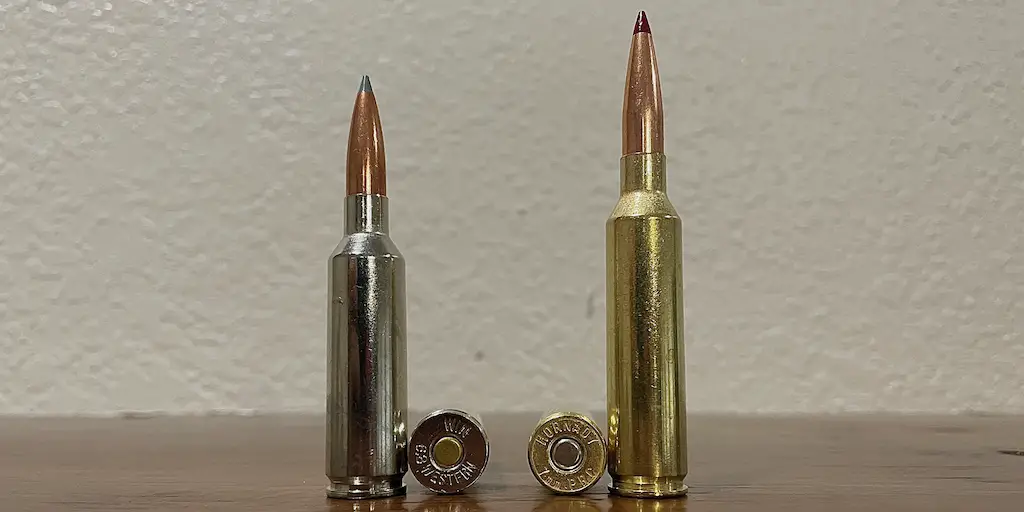
Bullet diameter and bullet weight are two other important differences between the 6.8 Western vs 7mm PRC.
First, the 6.8 Western uses .277″ bullets while the 7mm PRC uses slightly larger .284″ bullets.
Most 6.8 Western factory loads shoot bullets in the 162-175 grain range. 162 grain, 165 grain, 170 grain, and 175 grain loads are by far the most common.
On the other hand, the 7mm PRC most often uses bullets in the 150-180 grain range, with 160 grain bullets, 175 grain bullets, and 180 grain bullets being most common. In particular, it was specifically designed from the start to use high BC 160gr monometal and 175gr and 180gr lead core bullets.
We’ll discuss the impacts of these differences in bullet diameter and bullet weight in more detail later in this article.
Finally, the 6.8 Western and 7mm PRC are loaded to the same SAAMI maximum average pressure of 65,000psi.
Note: while the powder capacity figures listed below do give a good indication of the differences between the two cartridges, exact case capacities vary slightly according to the brand of brass used.
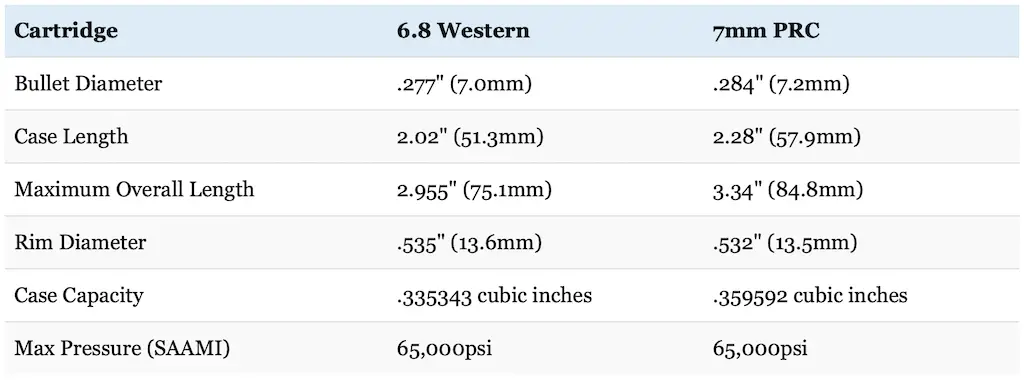
6.8 Western vs 7mm PRC Ballistics
The differences in the external dimensions of these cartridges also translate into some stark differences in their ballistic performance. This is illustrated in the table below comparing some of the premier loadings for each cartridge.
At this time, the 6.8 Western and 7mm PRC are not available in the same factory loads. This makes it difficult to do an exact “apples to apples” comparison, but comparing the popular factory loads at this instant will still provide useful information on their performance afield.
Specifically, the 6.8 Western loads below are from the Winchester Expedition Big Game Long Range, Winchester Copper Impact, and Browning Long Range Pro lines with 165gr AccuBond Long Range (.620 BC), 162gr Copper Impact (.564 BC), and 175gr Sierra GameChanger (.617 BC) bullets respectively.
Likewise, the 7mm PRC loads below are from the Hornady Outfitter and Hornady Precision Hunter lines using 175gr ELD-X (.689 BC) and 160gr CX (.596 BC) bullets.
Note: the CX and Copper Impact are lead free monolithic projectiles designed by Hornady and Winchester respectively to deliver high weight retention and deep penetration. However, as a monolithic projectile, those bullets do not have nearly as high of a BC as the ELD-X, ABLR, or GameChanger projectiles.
It’s also worth mentioning that the Sierra Tipped GameChanger is sometimes referred to as the Sierra Tipped GameKing bullet or the Sierra TGK.
Additionally, while the ELD-X and AccuBond Long Range are designed to expand at velocities as low as 1,350fps (for the ABLR) and 1,600fps (for the ELD-X), the Game Changer requires about 1,800fps of impact velocity for optimum performance. Likewise, the Copper Impact and CX both require an even faster impact velocity of at least 2,000fps for optimal terminal performance.
Before going into the details of comparing the ballistics of those cartridges, I want to point out that the various bullets used in those 7mm PRC loads all have a higher BC than those used in the comparable 6.8 Western loads.
All five loads used a 200 yard zero.
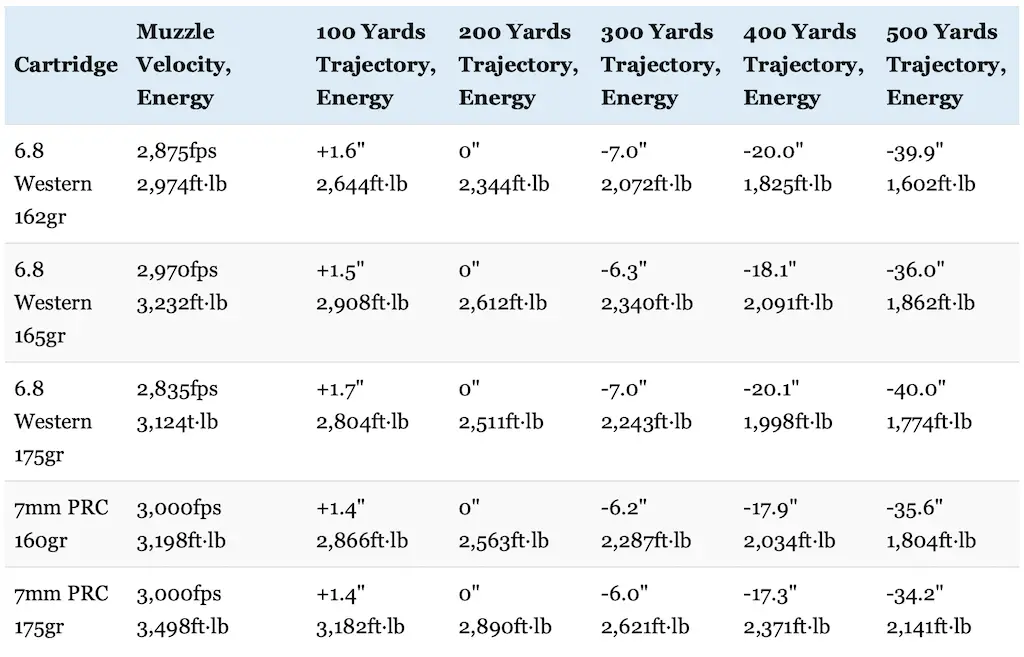
As you can see, the 160gr and 175gr 7mm PRC loads are actually the flattest shooting loads of the bunch. Though the 165gr ABLR load for the 6.8 Western tracks the 160gr CX pretty closely, it still has about a half inch more bullet drop than the CX load and nearly two inches more bullet drop than the 175gr ELD-X load at 500 yards.
That really says something when a monometal bullet like the 160-grain CX is shooting flatter than lead core projectiles in another high performance cartridge.
This is due to the fact that both 7mm PRC loads have a higher muzzle velocity than the 6.8 Western and also shoot very high BC bullets. Heck, the 7mm PRC is flinging a 175gr bullet with an exceptionally high BC 125-185fps faster than the 6.8 Western shoots a 162gr or a 175gr bullet.
It also has a substantial BC and about a 30fps muzzle velocity edge over the flagship 165gr AccuBond Long Range loading for the 6.8 Western.
However, all these loadings (but especially the 7mm PRC loads) are relatively flat shooting and just 5.8″ separates the flattest shooting load from the most arching load at 500 yards.
Not surprisingly, the 7mm PRC also has more muzzle energy across the board than the 6.8 Western. Even so, the 6.8 Western still does pretty well here and all three loads for that cartridge carry over 1,600 ft-lbs of kinetic energy out past 500 yards (over 1,800ft-lbs in the case of the 165gr AccuBond Long Range).
While the 165gr ABLR load for the 6.8 Western has a little more muzzle energy than the 160gr CX load for the 7mm PRC, the 7mm PRC ELD-X load has about 8-18% more muzzle energy than the various 6.8 Western loads.
The 160gr CX load for the 7mm PRC has about 13% more retained kinetic energy than the 162gr Copper Impact load, about 2% more retained energy than the 175gr Sierra load, and about 3% less retained energy than the 165gr AccuBond Long Range load for the 6.8 Western at 500 yards.
Think about that for a second too.
The 165gr and 175gr loadings for the 6.8 Western are fantastic options using two of the highest BC bullets available for that cartridge in a factory offering, but the 7mm PRC has a load using a much tougher monometal bullet that shoots a tiny bit flatter and has basically the same amount of retained energy at 500 yards!
That sort of performance with a monometal bullet was basically unheard of until now.
Additionally, the much higher BC 175gr ELD-X load has 15-34% more retained energy than all three 6.8 Western loads at 500 yards.
So, the big takeaways so far are that the 7mm PRC is the flattest shooting cartridge of the bunch and that 175gr ELD-X load has the most retained energy at 500 yards, but the 6.8 Western still holds its own pretty well and is no slouch by any stretch of the imagination.
Those trends continue as we look out to even longer ranges. Note that I’m not advocating using either cartridge for hunting at extreme range, but things start to get pretty interesting as ranges increase.
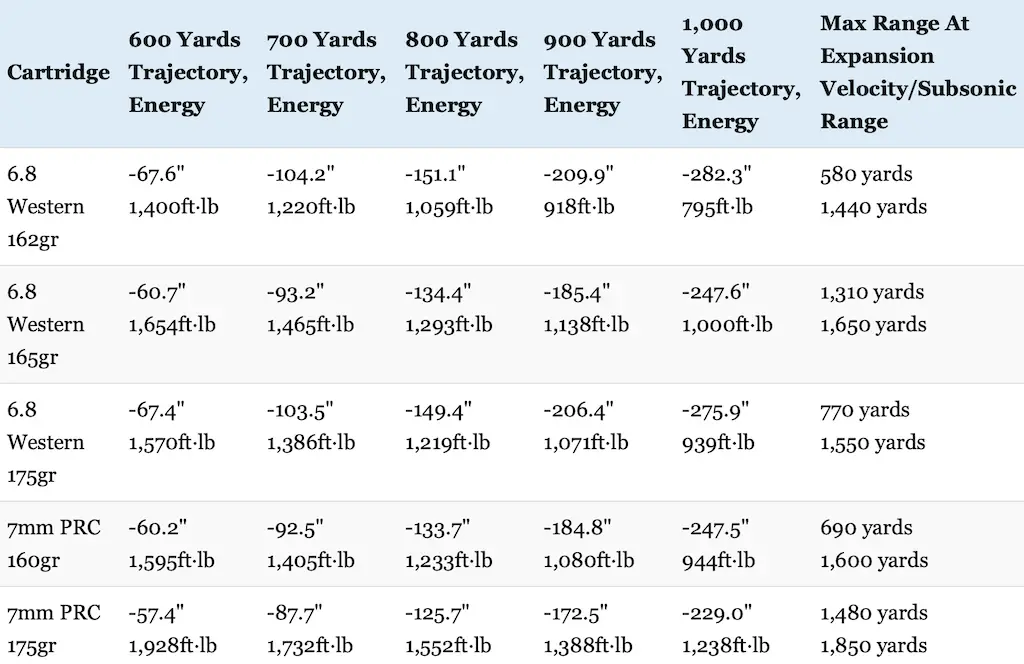
Once again, the 7mm PRC has the flattest trajectory of the bunch.
Interestingly, the 175gr ELD-X loading for the 7mm PRC has 24-32% more kinetic energy remaining at 1,000 yards than the 165gr and 175gr loadings for the 6.8 Western. Once again, this is because that 175gr ELD-X has the highest BC of all bullets used in this comparison which allows it to retain energy and velocity better than everything else.
Even that 160gr CX loading for the 7mm PRC still carries over 1,500 ft-lbs of kinetic energy out past 500 yards, over 1,000 ft-lbs of energy out past 900 yards, and doesn’t dip below its minimum recommended impact velocity until nearly 700 yards, which is nearly as impressive as the performance of the 175gr Sierra load and is also a substantial improvement over the 162gr Copper Impact loading for the 6.8 Western.
Now let’s talk about another important factor: wind.
The chart below compares how much a 10 mile per hour crosswind impacts those same 6.8 Western and 7mm PRC loads out to 500 yards.
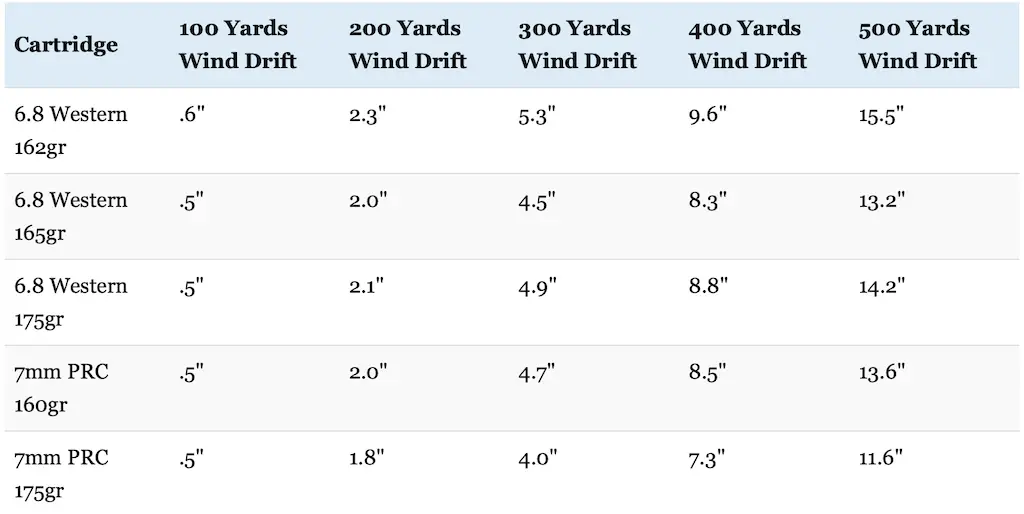
Those same general trends hold true with regards to wind deflection, but this is where that 175gr ELD-X load for the 7mm PRC really starts to stand apart from the others.
The 7mm PRC ELD-X has the least wind deflection, followed by the 6.8 Western 165gr ABLR, the 7mm PRC 160gr CX load, the 6.8 Western 175gr Sierra load, and finally the 6.8 Western Copper Impact.
While all of these loads (but to a lesser extent with the 162gr Copper Impact) have excellent wind bucking characteristics, the 175gr ELD-X, the 165gr ABLR, and the 160gr CX all have similar wind deflection out at 500 yards.
I’d go so far as to say that having less than 12″ of wind deflection at 500 yards with a 10 mph full value crosswind is absolutely outstanding. Indeed, that 175gr ELD-X loading for the 7mm PRC delivers some of the best performance in windy conditions currently available for big game hunting ammo right now.
That 160gr CX also has virtually the same amount of wind deflection as the 165gr ABLR from the 6.8 Western at 500 yards as well (which is still really good).
The 6.8 Western ABLR and 7mm PRC ELD-X loads look pretty closely matched in this area at first. However, while that 1.6″ of difference in wind deflection between the 175gr ELD-X and the 165gr ABLR from the 6.8 Western at 500 yards might not sound like a tremendous amount, that’s still a 14% advantage in favor of the 7mm PRC.
Those differences become even more apparent at longer range too.
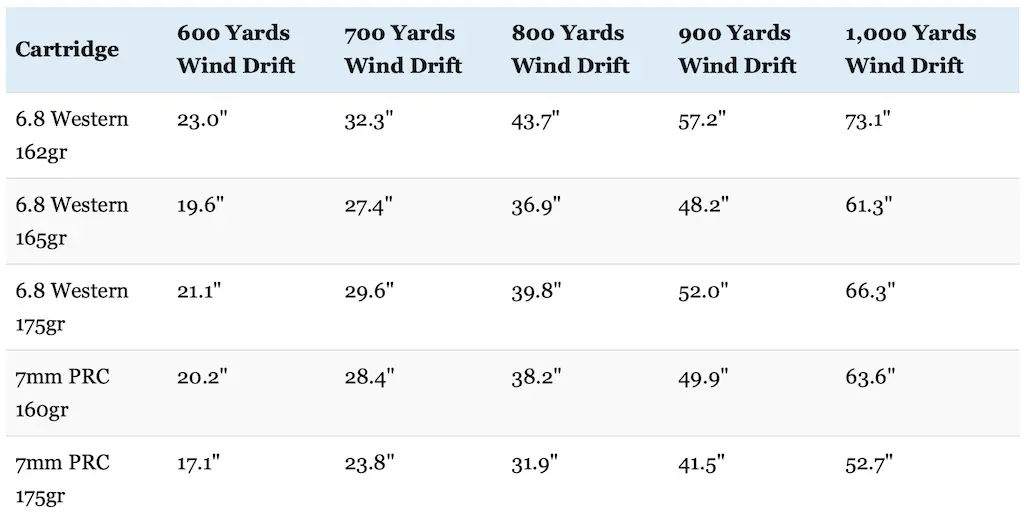
For instance, the advantage that 175gr ELD-X load has over the 6.8 Western continues to grow as the range increases.
This is an area where the 7mm PRC really shines with a combination of a high muzzle velocity and a very high BC bullet in the 175gr ELD-X.
Indeed, it performs a lot better than most comparable loadings at extended range and a hunter or shooter looking for that little bit of an advantage would be well served to look at the 175gr ELD-X loading for the 7mm PRC here.
Why is this the case?
Assuming the same wind conditions, wind deflection is dependent on bullet velocity and BC. However, small changes in ballistic coefficient result in bigger changes in wind deflection than is the case with velocity.
For this reason, the 7mm PRC load firing the super high BC 175gr ELD-X at a faster velocity comes out on top here.
Once again, the 6.8 Western (especially that 165gr ABLR loading) still holds its own pretty well and also delivers very good performance in the wind. That’s hands down the best load for the 6.8 Western on paper and it also edges the 160gr CX load for the 7mm PRC slightly.
External ballistics don’t tell the whole story though and there’s more to picking a hunting cartridge than kinetic energy, bullet drop, or wind drift at various ranges.
For instance, now let’s talk about recoil.
The table below compares the recoil produced by handloads that are very similar to the 165gr and 175gr loads for the 6.8 Western and 7mm PRC respectively when fired from identical rifles.
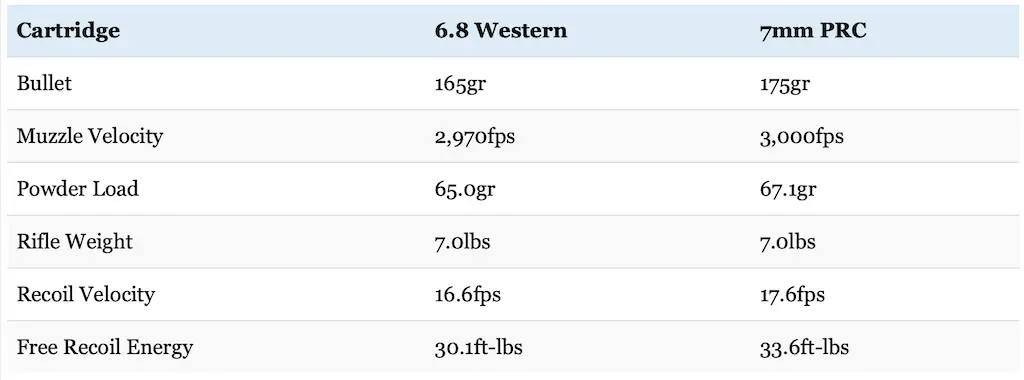
Felt recoil will vary from shooter to shooter and rifle to rifle, but free recoil energy is still a useful way to compare cartridges.
As you can see, the both cartridges have fairly stout recoil, but the 7mm PRC has a little more recoil than the 6.8 Western with this particular loading.
That load fires a heavier bullet at a faster velocity and uses a little more powder to achieve that performance. The end result is that the 7mm PRC has about 11.6% more free recoil energy than the 6.8 Western.
Now, 7mm PRC doesn’t have a ridiculous amount of recoil. The recoil produced by this particular load is certainly stout, but it’s also not so excessive that it’s impossible to shoot.
For reference, my 7mm PRC has noticeably less recoil than typical .300 Win Mag loads.
On the other hand, the 6.8 Western is just a lighter recoiling cartridge.
While the 6.8 Western does indeed have less recoil, I feel like both cartridges have the sort of recoil that many people can handle without a lot of trouble, especially when shooting a rifle that fits them well, that has a good recoil pad, or is equipped with a muzzle brake or suppressor.
Even so, it’s still worth mentioning that the 7mm PRC does kick more than the 6.8 Western.
Don’t underestimate the impact that recoil has on the ability of a person to shoot accurately either. Some people do handle recoil better than others, but all other things being equal, they will absolutely shoot more accurately with a milder recoiling cartridge.
Additionally, there are a couple of other factors that are also worth discussing.
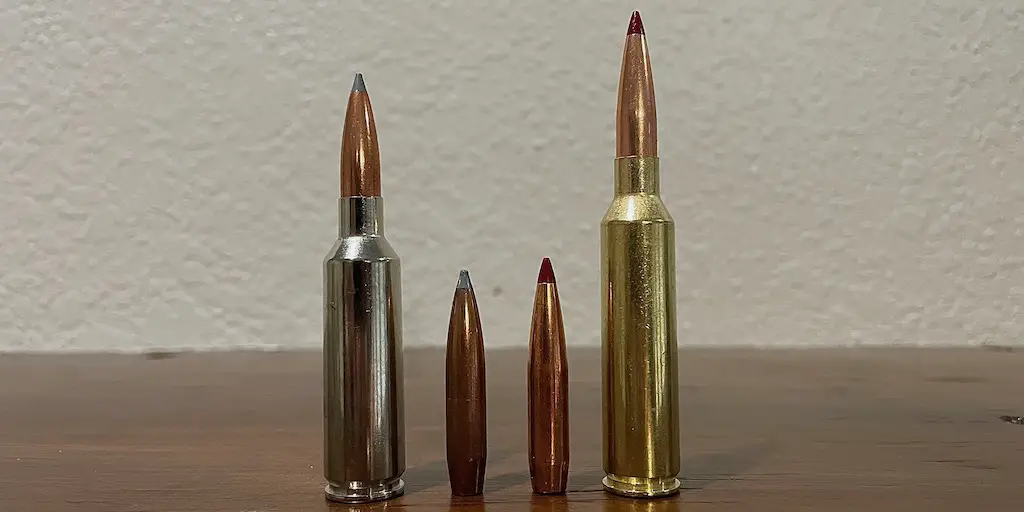
First, the 7mm PRC uses larger diameter bullets than the 6.8 Western.
Specifically, the larger diameter .284″ bullets used by that 7mm cartridge has about 5% more frontal surface area (also known as cross sectional area) than the .277″ bullets used by the 6.8 Western (.0633 vs .0603 square inches). All other things being equal, a bigger bullet will make a bigger hole, cause more tissue damage, and result in more blood loss.
This is a small advantage in favor of the 7mm PRC.
Especially when combined with the fact that the 7mm PRC carries more kinetic energy downrange, those larger diameter bullets can also be helpful when hunting big game.
Additionally, as we covered earlier, many of those longer, heavy for caliber .284″ bullets the 7mm PRC uses have a higher ballistic coefficient than the most common bullets used in the 6.8 Western, especially when bullet weights are similar.
For instance, the .277″ 165gr AccuBond Long Range and 175gr Sierra GameChanger bullets used by the 6.8 Western have G1 BCs of .620 and .617 respectively. Those bullets have very high BCs themselves, but still fall a little short of the .284″ 175gr ELD-X used by the 7mm PRC with a G1 BC of .689.
As another example, that .284″ 160gr CX has a G1 BC of .596 which outclasses the .564 BC of the .277″ 162gr Copper Impact.
While those differences are indeed small in favor of the 7mm PRC, they are still worth considering because those slightly more aerodynamic projectiles don’t slow down as fast and are more resistant to wind drift.
On the other hand, the 6.8 Western has an edge in terms of bullet sectional density (SD) in some cases.
Sectional density (SD) is a measure of the ratio of the diameter of a projectile to its mass. All other things equal, a heavier projectile of a given caliber will be longer and therefore have a higher sectional density and consequently penetrate deeper than projectiles with a lower mass and sectional density.
162 grain, 165 grain, 170 grain, and 175gr .277″ bullets have sectional densities of .302, .307, .317, and .326 respectively. At the same time, 160 grain and 175 grain .284″ bullets have sectional densities of .283 and .310.
So, the 6.8 Western has a small edge over the 7mm PRC in terms of bullet sectional density when comparing their 162gr Copper Impact to the 160gr CX as well as when comparing the 170gr Power Point and 175gr Sierra to the 175gr ELD-X.
However, the 7mm PRC 175gr ELD-X has a small edge over the 165gr AccuBond Long Range.
To be fair though, the 165gr Accubond Long Range is generally a tougher bullet than the 175gr ELD-X because it has a bonded core (which the ELD-X lacks). All other things equal, I’d expect the 165gr ABLR to penetrate a little deeper than the 175gr ELD-X and retain a little more weight.
There’s nothing wrong with the killing power or penetration capabilities of the 7mm PRC, but this is a potential advantage in favor of the 6.8 Western and could help the cartridge perform better on game than one might think from just looking at the ballistics of the cartridge on paper.
7mm PRC vs 6.8 Western Accuracy
What about 6.8 Western vs 7mm PRC accuracy?
While external ballistics are extremely important, performance on paper doesn’t mean a darn thing if you can’t hit your target.
Like I mentioned earlier, Winchester and Hornady both implemented some modern cartridge design principles with the 6.8 Western and 7mm PRC to help optimize accuracy.
John Snow wrote a fantastic article on this subject for Outdoor Life, but long story short, companies designing new cartridges these days typically employ more modern cartridge design principles that incorporate best practices obtained from competition and benchrest shooters to obtain the best possible accuracy.
Cartridges designed using these principles use faster twist rates to stabilize heavy, high BC bullets, have cases with a long enough neck to support those longer, high BC bullets, can seat those long, high BC bullets to the SAAMI specified maximum overall length without intruding into the powder column, employ minimal body taper, headspace off sharp shoulders, and have a chamber design with a snug throat.
Taken together, these design principles result in cartridges with a very high degree of accuracy potential, especially at extended range.
Like I mentioned earlier, both the 6.8 Western and 7mm PRC design incorporate all of those principles.
Let’s drill down into things in more detail.
First, the throat is the smooth portion of a rifle barrel closest to the cartridge. Having a more snug throat diameter means there’s less room for the bullet to yaw upon firing before engaging the rifling, which can help enhance accuracy.
Well, the 7mm PRC and 6.8 Western have throat diameters just .0006″ and .0011″ larger than the bullet diameter respectively.
Of these two cartridges, the 6.8 Western does have more “slop” in its chamber design than the 7mm PRC, but it still has a pretty “snug” throat diameter compared to older cartridges like the 243 Winchester (.0033″), .264 Win Mag (.004″), or even the 308 Winchester (.002″).
Additionally, both cartridges utilize a steeper shoulder for headspacing (30 degrees for the 7mm PRC and 35 degrees for the 6.8 Western), have a faster SAAMI spec rifling twist, and have a long enough case neck and has ample head height to use those long, heavy, high BC bullets I keep talking about.
Taken together, all of these factors result in excellent accuracy potential for the 6.8 Western and 7mm PRC, especially with long, heavy, high BC bullets.
Additionally, the 6.8 Western is a short action cartridge. In general, short action cartridges sometimes have an advantage in terms of accuracy due to their use with shorter and stiffer bolt as well as the fact that they have a shorter and fatter powder column that can burn more consistently.
Which one is better?
It’s really tough to say for certain because both are capable of excellent accuracy, but I’d lean a little towards the 7mm PRC here.
Details will vary on the exact rifle, ammunition, and shooter in question. However, the 7mm Precision Rifle Cartridge probably has some of the best potential for accuracy available today using factory rifles and ammunition.
So where do we stand overall?
7mm PRC vs 6.8 Western
The 7mm PRC fires larger diameter, higher BC, and usually heavier bullets at a faster velocity than the 6.8 Western. For this reason, the 7mm PRC typically has more recoil, a flatter trajectory, more retained kinetic energy, and better resistance to wind deflection.
6.8 Western vs 7mm PRC Ammo
Both are very new cartridges and ammunition options for the 7mm PRC and 6.8 Western are more limited than is the case with older and more established rounds like the 7mm Rem Mag.
That’s not to say that either is rare, but options are limited for both cartridges.
At this time, Browning and Winchester are the primary sources of factory 6.8 ammo.
Specifically, the Winchester Expedition Big Game Long Range line loaded with 165gr Nosler AccuBond Long Range bullets, the Browning Long Range Pro Hunter line loaded with 175gr Sierra GameChanger bullets, the Winchester Ballistic SilverTip line loaded with 170gr Ballistic SilverTip bullets, the Winchester Power Point line loaded with 170gr Power Point bullets, and the Winchester Copper Impact line loaded with 162gr Copper Impact bullets are the only loaded ammo options I’m aware of for the 6.8 Western cartridge.
Released in 2021 right in the middle of the 2020-2023 ammo shortage, 6.8 Western ammunition availability has dramatically fluctuated over the past couple of years.
To the great frustration of many, the 165gr AccuBond Long Range loading has been extremely difficult to find at times as it has disappeared from retailer’s shelves for months at a time. That was less of a problem with the Browning and especially the Copper Impact loadings though, which have been much easier to obtain in general.
On the other hand, the 7mm PRC is literally brand new, but has become extremely popular in an astonishingly short amount of time.
At this instant, Hornady is the primary company that manufactures factory 7mm PRC ammo. They currently offer three loads for the cartridge: an offering in their Match line loaded with a 180 grain ELD Match bullet, an offering in their Outfitter line with a 160 grain CX bullet, and an offering in their Precision Hunter line with a 175-grain ELD-X bullet.
While that Match ammo is great for use at the range, look at the Outfitter and Precision Hunter 7 mm PRC loads for hunting, both of which are excellent for hunting all manner of game in North America and elsewhere in the world.
Federal recently started making 7mm PRC ammo as well in their Premium and Terminal Ascent lines using the 175gr ELD-X and the 155gr Terminal Ascent. Remington also recently picked up the cartridge and now offers 7mm PRC factory ammo loaded with a 175gr Speer Impact bullet.
Additionally, 7 mm PRC ammo prospects are looking very good in the near future and there are also rumblings that other companies might pick up the cartridge as well.
Smaller more “boutique” companies like Choice Ammunition make custom handloads for both cartridges utilizing other bullets too.
For instance Choice Ammunition and Hendershot’s produce custom 7mm PRC ammo with a couple of different bullet options from Barnes, Berger, Hammer, and Nosler.
Likewise, Choice Ammunition produces 6.8 Western ammunition with a couple of different bullets from Berger and Nosler as well. Barnes also started producing a 155gr LRX component bullet for the 6.8 Western as well.
Ammo availability is also usually decent online and the bigger retailers typically have a good selection of quality factory ammo for both cartridges as well.
If you’d like to learn more about some of the various hunting ammunition choices for the 7mm PRC or 6.8 Western cartridges, read the articles below:
Best 6.8 Western Ammo For Hunting Elk, Deer, Bear, Hogs, & Other Game
Best 7mm PRC Ammo For Hunting Elk, Deer, Bear, & Other Game
Handloaders will appreciate the fact that reloading components for these cartridges are available and there’s an excellent variety of bullet choices for each cartridge. So, you should not have any trouble working up a good custom load for either one if you like to handload.
The 7mm PRC all uses the same .284″ bullet size as other popular 7 mm cartridges like the 7mm-08, 280 Remington 280 Ackley Improved, 7 mm Remington Magnum, 7mm SAUM, 7mm WSM, 7 mm STW, 28 Nosler, and 7mm Weatherby Magnum (among others).
The 6.8 Western uses the same .277″ bullet size as the .270 Winchester, the 270 WSM, the 6.8 Remington SPC, and the 270 Weatherby. While those Winchester and Weatherby cartridges in particular use a slower rifling twist rate than the 6.8 Western, the 6.8 Western cartridge will readily shoot those lighter 130-150gr bullets most commonly used in those chamberings without issue.
Bullets like the Barnes LRX, TSX, and TTSX, the Berger VLD and Hybrid Hunter, the Hornady ELD-X, GMX, InterBond, InterLock, SST, and V-Max, the Nosler AccuBond, Ballistic Tip, E-Tip, and Partition, the Sierra GameChanger and GameKing, the Swift Scirocco and A-Frame, (just to name a few) are options for if you want to reload the 7mm PRC and the 6.8 Western.
7mm PRC vs 6.8 Western Rifles
The rifle situation with the 6.8 Western and 7mm PRC is similar to the ammunition situation.
At this time, Browning and Winchester are the primary manufacturers producing rifles in 6.8 Western.
However, there’s a pretty good selection of 6.8 Western rifles available from both companies. As of early 2023, 6.8 Western rifles include 23 different versions of the Browning X-Bolt, 16 versions of the Winchester XPR, and 11 versions of the Winchester Model 70 bolt action rifles.
Heck, Winchester just released a new version of their XPR Hunter TrueTimber Strata in 6.8 Western with a left-handed bolt in late 2023! This is the first left handed 6.8 Western rifle I’m aware of.
Christensen Arms also picked up the 6.8 Western in 2023. At this instant, they produce their Mesa FFT, Mesa FFT Titanium, Ridgeline FFT, and Ridgeline FFT Titanium models in 6.8 Western.
Seekins Precision and Fierce Firearms also started producing rifles in 6.8 Western in 2023 as well and currently offer the cartridge in a couple of different models.
As far as the 7mm PRC goes, rifle manufacturers like Browning, Christensen Arms, Fierce Firearms, GA Precision, Gunwerks, Hill Country Rifles, Mossberg, Proof Research, Remington, Ruger, Savage Arms, Seekins Precision, and Springfield Armory all produce rifles chambered in 7mm PRC.
Christensen Arms also makes left handed 7mm PRC rifles in their Ridgeline series (I have a left-handed Ridgeline FFT in 7mm PRC myself).
That list of 7 mm PRC rifles will likely continue to grow as well.
Which one is easier to find?
Well, it depends and availability for the 6.8 Western in particular has really fluctuated since its release.
The 6.8 Western was first released during the middle of the big ammo shortage in early 2021, which actually meant that rifles in that chambering were fairly easy to come by until the last couple months of the year.
In fact, I knew of several instances where hunters who couldn’t find ammo in their favorite cartridge during the terrible shortage in 2021, but purchased rifles in 6.8 Western specifically because they were available and they could get ammo for them.
Things have improved quite a bit as I write this in late 2023 though.
I wouldn’t say that rifles in either cartridge are especially common, but neither is rare either. Of the two, 7mm PRC rifles are probably more common and easier to find right now.
It’s also important to realize that gun manufacturers tend to put longer barrels on rifles chambered in magnum cartridges in general. This is because those cartridges need a longer barrel to effectively and efficiently burn that larger powder charge.
This holds true for both cartridges, but both actually work surprisingly well out of shorter barreled rifles.
The 7mm PRC is available in rifles with 20″, 22″, and 24″ barrels and actually performs surprisingly well out of a shorter barrel.
The 6.8 Western is normally available in rifles with a 24″ barrel, though some models have 26″ barrels. A handful of models have shorter 22″, or even 20″ barrels in some cases (though those shorter barrels are somewhat unusual and are most common on “suppressor ready” models).
While the both cartridges are often available in rifles of the same size and length, it’s important to note that the 6.8 Western will have a slight advantage over the 7mm PRC for those looking for a lighter and/or more compact rifle because it’s a short action cartridge.
Here’s an example that illustrate this point.
Browning manufacturers their X-Bolt Speed Suppressor Ready rifle in both cartridges.
The variant chambered in 6.8 Western has a 20″ barrel and an overall length of 40″.
The variant chambered in 7mm PRC also has a 20″ barrel, but is 40.75″ long.
I wouldn’t say that either one is especially big or bulky, but the 6.8 Western rifle is definitely a little more compact.
Having a shorter and handier rifle is more important on some hunts than on others. So, just keep that in mind.
If you’d like to learn more about some of the various hunting rifle choices for the 6.8 Western and 7mm Precision Rifle Cartridge, read these articles:
Best 6.8 Western Hunting Rifles
6.8 Western vs 7mm PRC: Which Is Right For You?
Before we move on, I have to answer the question: will the 6.8 Western and 7mm PRC last? Or are they just the latest flash in the pan that will disappear after a couple of years?
This is a tough question to answer.
Nobody wants to buy a rifle chambered in a new hotrod cartridge only for the manufacturer to discontinue production of rifles and factory ammo just a couple of years down the road.
On one hand, I can understand why many people don’t want to use something (especially something new) that’s uncommon. On the other hand, a lot of people have to start using that new cartridge for it to BECOME common.
So, what does the future hold?
My crystal ball is a bit murky, but I wouldn’t be surprised if both cartridges stick around for many years.
I’d go with the 7mm PRC if I had to pick the one most likely to have the best long term success though. It’s really hard for me to bet against Hornady’s design and marketing teams. Plus, the company also did an outstanding job of getting a large number of other manufacturers to pick up the cartridge right out of the gate.
I’m not exaggerating when I say that I’ve never seen anything explode in popularity quite like the 7mm PRC did.
While the 6.8 Western did not get off to as big of a roaring start, it seems to have really found a home in a particular segment of the hunting community. The fact that it outperforms the 7mm Rem Mag with a little less recoil AND also fits in a short action rifle are all important advantages in its favor.
Truth be told, I think the fact that the 6.8 Western is a true short action cartridge will be what saves it in the long run.
Get back with me in 10 years and we’ll see how accurate those predictions are…
Now that we’ve got that out of the way, let’s talk about the how each cartridge performs in a couple of different hunting situations.
Do you primarily hunt medium sized game like whitetail deer, feral hogs, or black bear at ranges within 200 yards? Both are extremely effective deer hunting cartridges and will absolutely get the job done on medium sized game if you do your part. There really isn’t a significant difference between the 6.8 Western and 7mm PRC on deer inside of 200 yards and both are more than powerful enough for that sort of work.
If you’re going to be hunting in thick brush or in the tight confines of a deer stand, remember what I just mentioned about the barrel length difference with 6.8 Western vs 7mm PRC rifles. That extra couple of inches in overall length of a rifle can be a real headache to deal with when trying to quickly and quietly maneuver for a shot. Not that either is a “bad” choice here, but of the two, a 6.8 Western rifle with a 20″ or 22″ barrel will definitely be easier to handle than a 7mm PRC rifle, especially if it has a 24-inch barrel.
Are you looking for the cartridge better suited for long range hunting for game like mule deer or pronghorn antelope in open country where you might need to take a shot at several hundred yards? Once again, they’ll both work really well in this role and situations like these are where they start to stand apart from other cartridges. The 7mm PRC definitely carries more energy out to extended range than the others, but the 6.8 Western is also an excellent choice here that nips right on the heels of the 7mm PRC with quite a bit less recoil and also fits in a smaller package.
Do you want a hunting cartridge that’s well suited for caribou, moose, elk, eland, kudu, or red stag hunting? Again, both will work extremely well when used on bigger game in North America, Africa, Europe, and elsewhere.
Most hunters do not need the capabilities of the 6.8 Western or 7mm PRC and something like the 7mm Rem Mag will work great for the majority of elk hunting situations. I personally don’t feel comfortable shooting game out past about 450 yards myself and several other popular hunting cartridges also perform great out that far (and even a little farther in the right hands) on really big game like elk and moose.
However, a person with the right shooting skills who wanted to extend their effective range by another couple hundred yards would be well served by the 6.8 Western or especially the 7mm PRC.
The 7mm PRC also has better resistance to wind across the board. Since windy conditions tend to be pretty common out west, wind resistance for a cartridge should not be overlooked. I wouldn’t blame someone for choosing the 6.8 Western, but I personally lean towards the 7mm PRC here and I think it’s a good choice for someone who wants a capable all-around hunting rifle for everything from deer up to elk and moose.
The 7mm PRC is unquestionably more powerful than the 6.8 Western (and also uses larger diameter bullets), but the 6.8 Western also performs really well here and also recoils quite a bit less.
Plus, it also fits in a more compact short action cartridge. In fact, one could make the argument that the 6.8 Western is the most efficient and balanced short action hunting cartridge available on the market today. So, it’s definitely worth considering for those who want a lighter rifle to take elk hunting in rougher country and/or among those who want magnum performance afield with a little bit less recoil.
Are you looking for a great cartridge for sheep, mountain goat, or tahr hunting where you need an effective cartridge with manageable recoil in a lightweight and easy to carry rifle? The 7mm PRC will certainly work, but I’d prefer the 6.8 Western here because it’s a short action cartridge and is available in shorter, lighter, and easier to carry rifles without terrible recoil. Sheep hunts are so unique and often so physically demanding that I’d prioritize those attributes over a bigger and heavier rifle in 7mm PRC, even if it has a little better ballistics on paper.
Are you specifically hunting brown or grizzly bear? What if you hunt in Canada or Alaska and need a heavy hitting cartridge just in case you find yourself on the wrong end of a grizzly/brown bear attack? I do not recommend either cartridge for actually hunting the big bears (or other species of dangerous game like cape buffalo), though they will work on the big bears in a pinch. Of the two, I’d much prefer the 7mm PRC, but I’d definitely prefer to carry something heavier like a .338 Win Mag (or a 375 H&H) in grizzly country.
Make sure you use premium, heavy for caliber 160gr (monolithic) or 175gr bullets if you go that route.
Are you sensitive to recoil and in need of a serious low recoil cartridge? Both cartridges have fairly stout recoil, but the 6.8 Western is definitely the better lower recoiling option here. Like I keep saying, this is the perfect cartridge for someone who wants magnum performance with less recoil.
The 6.8 Western and the 7mm PRC are both excellent rifle cartridges. While the 7mm PRC and 6.8 Western are both much newer and more specialized rounds that offer certain advantages to hunters and shooters, few hunters really need the extra capability offered by the cartridges and there’s still not a darn thing wrong with using something older and more established.
Though the differences between them (6.8 Western vs 7mm PRC) are fairly significant in certain respects, they’re all suitable for many hunting tasks ranging from hunting North American game to plains game in Africa to deer in the southern hemisphere.
So, carefully analyze your potential needs before making a decision. In the end, a lot of this decision comes down to personal preference, the exact game you’re after, and the conditions of your hunt. So, choose the one that you feel most comfortable with and it will probably serve you well afield. Good luck!
NEXT: BEST 6.5 CREEDMOOR AMMO FOR HUNTING ELK, DEER, & OTHER BIG GAME
NEXT: BEST GIFTS FOR HUNTERS
Enjoy this article comparing the 6.8 Western and 7mm Precision Rifle Cartridges? Please share it with your friends on Facebook and Twitter.
Hornady provided information for the history of the 7mm PRC and Guns and Ammo provided background information for the 6.8 Western. The data used to compare the trajectory and recoil of the cartridges was obtained from Hornady’s web site (here and here) as well as Winchester’s and Browning’s web sites (here, and here). Maximum pressure and data to compare cartridge sizes for the 6.8 Western vs 7mm PRC were obtained from SAAMI (here and here). Case capacity information for the 6.8 Western vs 7mm PRC were obtained from Backfire.TV. Frontal surface area information was obtained from Chuck Hawks. I used Shooters Calculator to compare trajectories, wind drift, and recoil for the cartridges.
Make sure you subscribe to The Big Game Hunting Podcast and follow The Big Game Hunting Blog on Facebook, Instagram, Twitter, and YouTube.
John McAdams is a proficient blogger, experienced shooter, and long time hunter who has pursued big game in 8 different countries on 3 separate continents. John graduated from the United States Military Academy at West Point and is a veteran of combat tours with the US Army in Iraq & Afghanistan. In addition to founding and writing for The Big Game Hunting Blog, John has written for outdoor publications like Bear Hunting Magazine, The Texas State Rifle Association newsletter, Texas Wildlife Magazine, & Wide Open Spaces. Learn more about John here, read some of John’s most popular articles, and be sure to subscribe to his show: the Big Game Hunting Podcast.

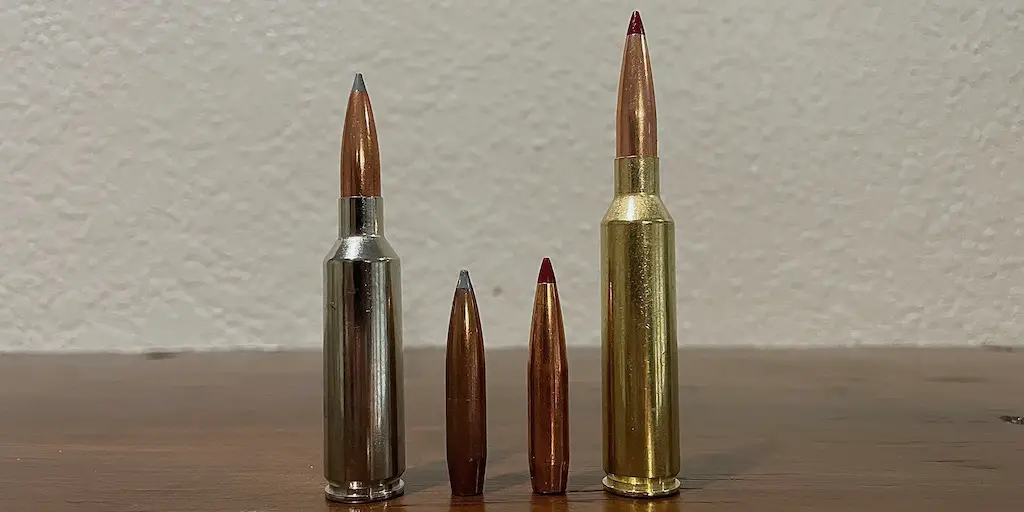
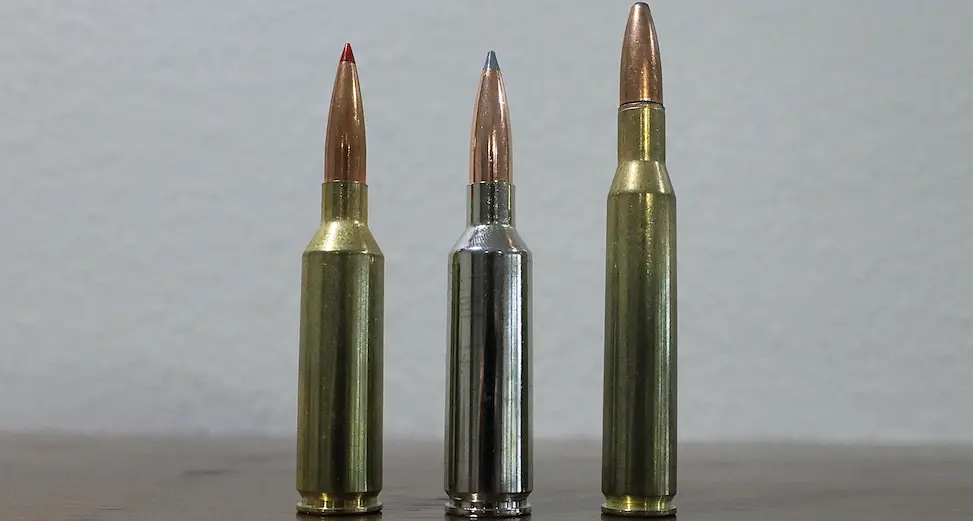
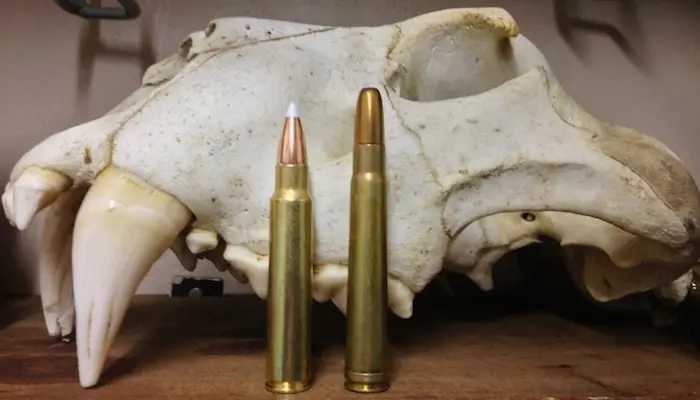
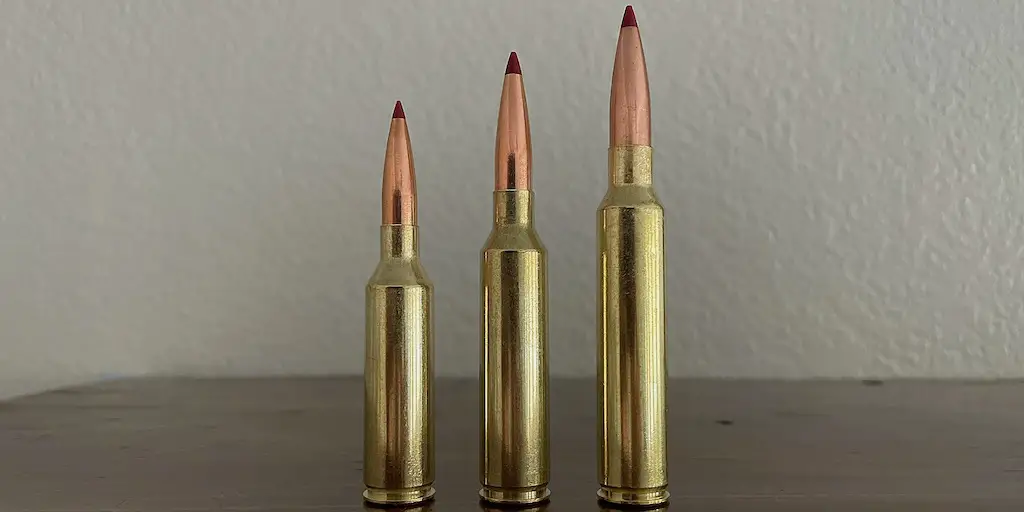

This is an excellent review! I was looking at both these new cartridges for my new rifle. I literally weighed every pro and con that I could research and find, in order to choose between these two. I ended up deciding on the 6.8 Western due to the short action/lighter weight rifle that I plan to use on a multi day expedition hunt. I chose the CA Ridgline that weighs 5.3lbs, and a Leupold 13oz VX-3 scope. For what I was looking for, this is the perfect setup. I’m still breaking in my barrel, but I’ve been so impressed up to this point… I really leaned towards the 7 PRC, but the difference in rifle weight made the difference to go with the 6.8 Western in the end…. I love my 6.5 PRC, so I knew the 7 PRC would duplicate’s the excellent accuracy and capabilities, but with more energy. Still, the 6.8 Western is right there on the heels of the 7 PRC.
So, everything written in this article was the exact same process and conclusion I came up with. I don’t think a person could go wrong with either. I have buddies that shoot both and have great success with both. More so the 6.8, only because it’s been out a little longer.
Again, excellent review that highlighted all points, while perfectly explaining the difference and similarities.
Superb write up. It will be interesting to see which or if both have a long market run.
“The proof is in the puddin” those numbers advertised/published on papers/ammo boxes into action and having actual proof they are accurate/true. I’ve been looking into getting a new rifle and have noticed a “few” comments regarding the published velocities not being obtainable. So how do I decide to choose a caliber that can’t create the ballistics it claims? or am I just imagining this because I haven’t bought several rifles and ammo to find the actual truth for myself? I’m even looking at getting set up for reloading(I own nothing for reloading) so that I may be able to get competitive with my choice of rifle. This may be an extensive “investment”???
I’ve done quite a bit of work regarding actual, real world velocities for both cartridges.
Learn more about the 6.8 Western here: https://youtu.be/HFym2F-p6kc
And the 7mm PRC here: https://youtu.be/4z28TJTQ-Rg